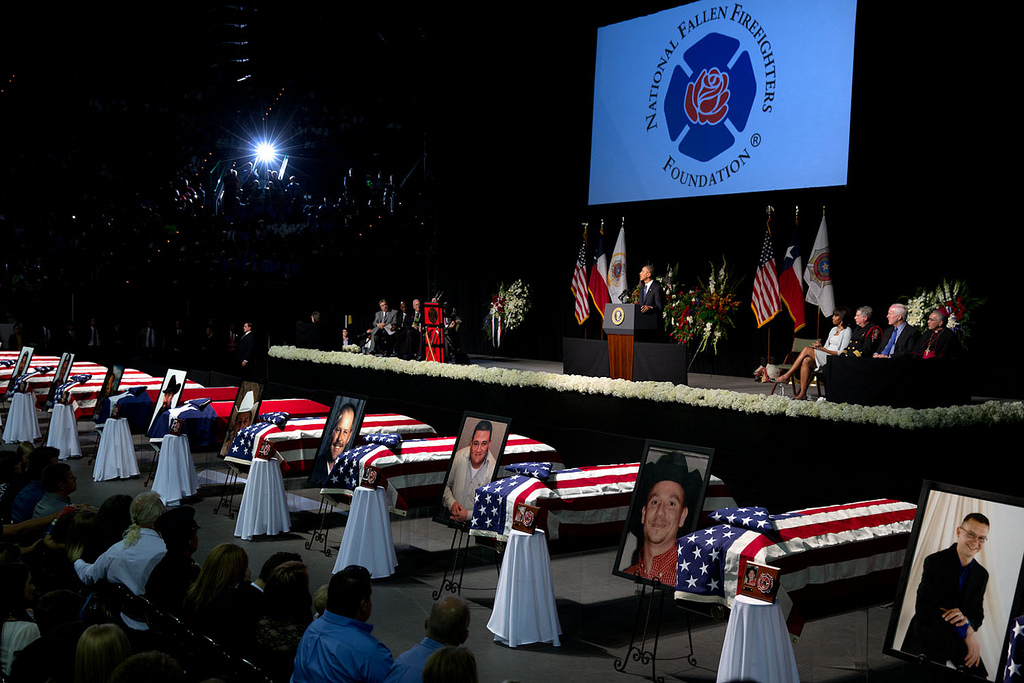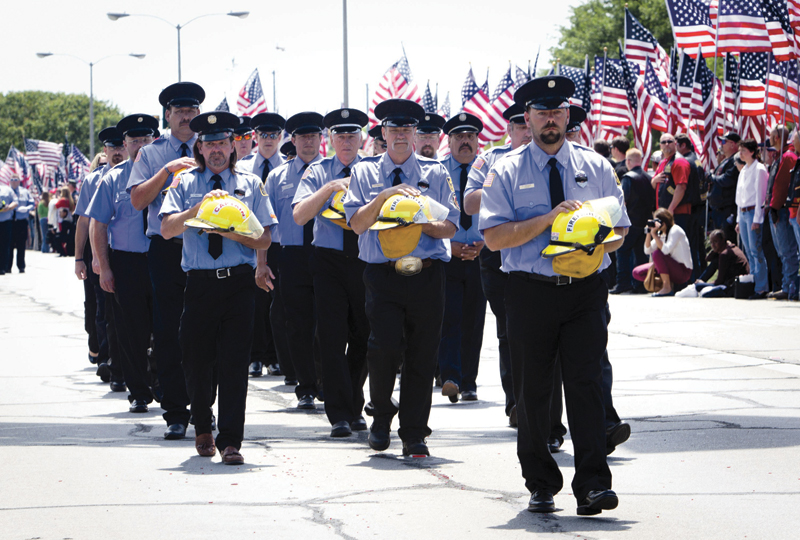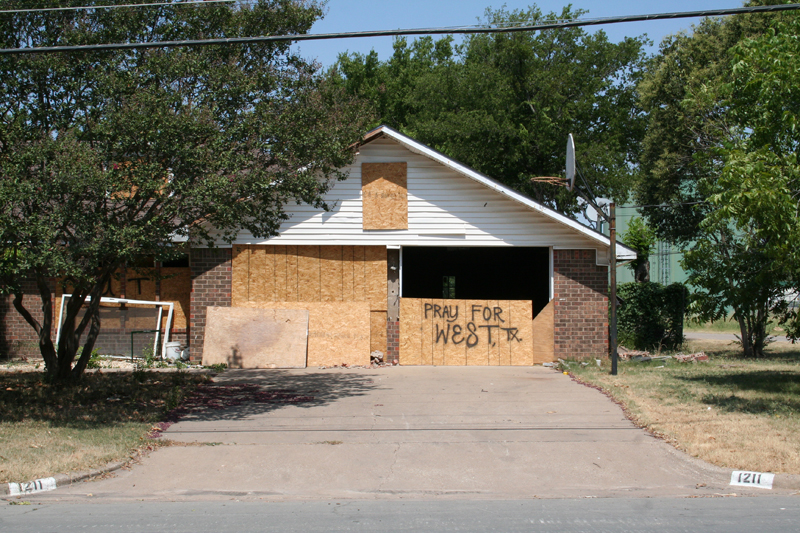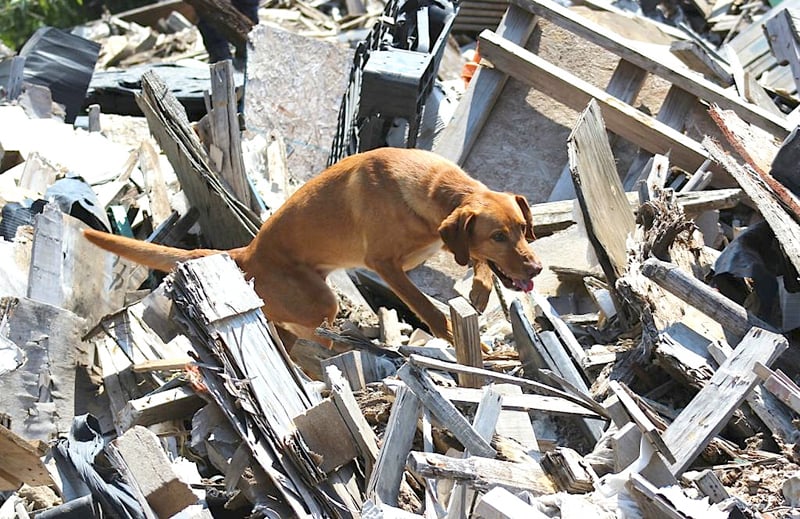
Rescue Dogs: The Canines and Their Handlers Who Search the Aftermath of Catastrophe

Above: Duke, a rescue dog.
When Mike Hargrove arrived in West, it was still dark, but he could clearly see the walls at the back of the apartment building were gone. They had been destroyed by the force of the explosion at a nearby fertilizer plant that had, just before 8 p.m. on April 17, killed at least 15 people, injured 160, and obliterated more than 100 homes in this close-knit community of 3,000 people.
As a 25-year police veteran, Hargrove had seen “catastrophic stuff,” as he put it, but nothing of this magnitude. Outside the apartment building—what was left of it—big chunks of dirt, rock and twisted metal from the complex had been tossed hundreds of feet in the air. The ceiling had collapsed, and insulation foam and bits of furniture littered the ground. Shining his flashlight into one of the rooms, Hargrove watched as Hayden scrambled over the debris and disappeared into the darkness.
A few years earlier, Hayden, a 7-year-old black Labrador mix with a penchant for chew toys, was found roaming the streets of Ventura County, California. Picked up by the Search Dog Foundation in Ojai, a small town nestled in a valley north of Los Angeles, the dog had undergone intensive training before he was ready to serve with Texas Task Force II, a state-run urban search and rescue organization based in Dallas. The dogs of Texas Task Force II are trained to search for live humans.
The West explosion was Hayden’s first assignment.
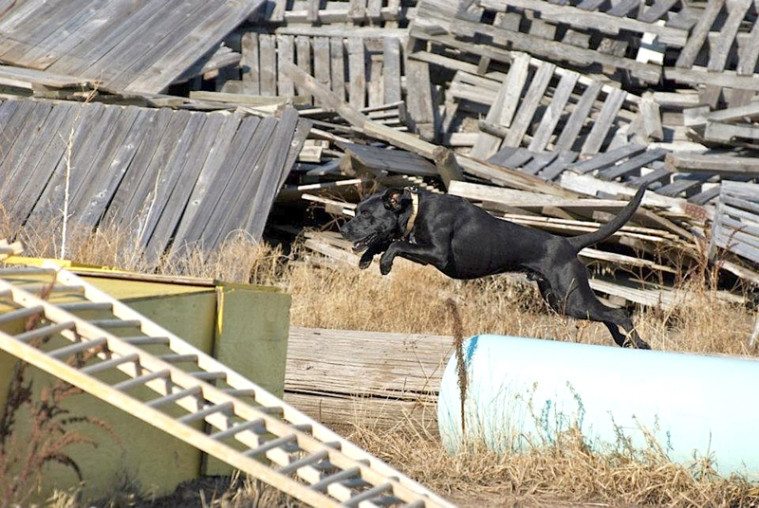
“It was like somebody had picked up the entire complex and shaken it,” Hargrove says. He’d been told that a woman had been pulled out alive from the apartment complex a little earlier, but that she couldn’t find her children. Hargrove and Hayden’s task was to search the ground floor of the complex for survivors. Hargrove shone his flashlight around the corridors and through open doorways, into holes in the rubble, providing some illumination to help Hayden. But for the most part the dog was following his nose—his training had taught him to hunt for human scent.
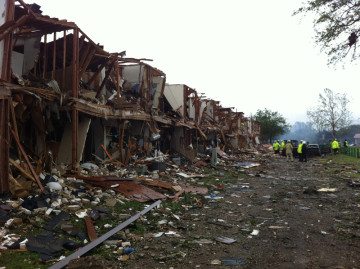
Steve Coffman, the program manager for Texas Task Force II says West was one of the most horrific incidents the team had searched in a long time—“just the size of the blast and the extent of the damage.” The majority of the volunteer members of Texas Task Force II are Dallas-area firefighters, and searching the rubble here was all the more harrowing because one of their own had died. Captain Kenny Luckey Harris Jr., known as Luckey, was a member of Dallas Fire-Rescue for 31 years. He had been in West that afternoon, cooking out with friends when he saw black smoke coming from the fertilizer plant. He had driven to the plant to tell firefighters to back off, that it wasn’t safe, when it exploded. “These incidents are just dramatic and stay with you a long time,” Coffman says.
Three hours after the explosion, Hargrove was at home in Colleyville watching the developments in West on TV with his wife, Mary, who’s also a rescue dog handler for the task force, when he got the message that the task force may be deployed to the disaster zone. Hargrove put Hayden in the car, and drove to his nearest urban search and rescue site, Station 33 in Dallas. There he collected his uniform (a gray t-shirt, navy blue pants and shirt inscribed with the Texas Task Force II insignia) and three deployment bags: a large one containing bed rolls, extra clothes and personal items, a smaller one with dehydrated food rations and supplies, and a third containing food, toys, first aid equipment, canine boots and towels for Hayden.
The team reached West a little after 2 a.m. For five-and-a-half-hours that morning, Hargrove and Hayden searched the wreckage non-stop, during which time the dog showed few signs of being tired. Then a cold front blew in, it began to rain, and they took a break. “We rested up for 45 minutes, got a little sleep, and once the weather had cleared—and the temperature had dropped 20 degrees—we went back out there,” Hargrove says.
Some buildings were still on fire the morning after the explosion, and even though Hargrove says there was no tell-tale smell in the air, he thought chemicals from the fertilizer plant must still be present. Handlers have to know their dogs: They have to be able to recognize when they’re getting too tired; if their breathing has changed as a result of inhaling dangerous fumes or trying to pick up scent when fiber-glass insulation material covers everything. “All these elements are being thrown at us when we’re on deployment,” Hargrove says. “So we need to be able to detect behavior changes in the dogs.”
Hayden had spent the previous year with Hargrove, training for this day in collapsed structures and rubble at a military base west of Dallas. He knew the commands, Hargrove’s hand signals, the tone of his voice, what to look for. Hargrove says he performed just as he had when they were on exercise. Two dead people were ultimately pulled out of that apartment complex: one before Hargrove and Hayden got there, another the next day when a second team of rescue workers arrived to remove all the furniture, personal effects and rubble from of the building. By mid-morning, Hargrove and Hayden had cleared the apartment. There were no survivors.
Texas Task Force II went operational in 2007 to respond to human-caused or natural disasters in the state, after Dallas Fire-Rescue proposed a search-and-rescue team that could complement the existing Texas Task Force I, a 70-member squad funded by the Federal Emergency Management Agency (FEMA) that responds to disasters country wide.
Depending on the type of emergency, Texas Task Force II will send three teams, each with 28 volunteers, or three teams each with 70 volunteers.
“We felt like threats within the North Texas area specifically — due to the weather and otherwise — required that this region have its own response team that could respond quicker,” Steve Coffman tells me.
Members of the task force are firefighters (15 Dallas-area fire stations provide volunteers), structural engineers, doctors, canine handlers and tech specialists. Coffman was one of the founders of Texas Task Force I, launched in the aftermath of the 1995 Oklahoma City bombing. With the aid of Department of Homeland security grants, Texas Task Force I got off the ground in 1998 and has become the most-deployed search and rescue team in the nation. It has responded to at least one major disaster each year since then, including the September 11 terrorist attacks and Hurricane Katrina.
Texas Task Force II, meanwhile, has been deployed seven times since its formation six years ago, including to hurricanes Ike and Gustav, the West explosion and the Granbury tornado that devastated parts of Hood County in May. Coffman describes it as an elite team that can be fully deployed to a disaster zone in just a few hours.
Texas Task Force II currently has four dog handlers. Five more, currently in training, will join the team later this year. All are taught to find survivors. None is what’s known as a “cadaver dog.” Steve Coffman says the dogs are incredible at what they do.
“They go into areas we really can’t send our rescue technicians, areas with a great deal of collapsed potential,” he said. “They can smell things we can’t even begin to get close to. We have high-tech listening devices, fiber optic cameras, but none matches the capability of a well-trained canine to make live finds. They’re truly amazing.”
Laurel Pitman has worked for Dallas Fire-Rescue since 1996. She joined the task force a couple of years ago as a canine handler. Her dog, Sonic, was rescued from Las Vegas by the Search Dogs Foundation, and Pitman spent a year training with him. In May, they deployed to Granbury to search for survivors of a tornado that sustained winds of up to 200 mph. Trucks were wrapped around trees, mobile homes had been picked up and thrown hundreds of yards, trees uprooted. Pitman and Sonic began searching about 2:30 a.m. and finished six hours later. “We had a couple of breaks here and there, but for the most part he was just going and going,” she tells me.
Texas Task Force 2, which consists of three separate teams of 28 people, went operational in 2007 to respond to man-made and natural disasters in north Texas. Since 2010, they have been using dogs to assist with these searches.
The first houses they searched weren’t destroyed, and Pitman says Sonic was sniffing around wondering what she wanted him to do. “Then we got to the fourth house, and it was a collapsed structure. A pile of debris. And it was like a light bulb went off. Sonic knew that’s what he was there for. He figured it out, and he just took off.”
Pitman says from then on Sonic went nonstop, dragging her from structure to structure. Sonic is trained to search solely for life. If he finds a survivor, he’ll bark. “It could be breathing they’re sensing — or the smell,” Pitman says. “We don’t know scientifically how they do it. But there’s a certain bark he makes, and I know he’s on a live human.”
Ken Sutcliffe, a 26-year veteran of Dallas Fire-Rescue, says hurricanes are logistically the most challenging, because there’s such a wide area of damage — tens of square miles of devastation — requiring vast amounts of manpower to search. The path of a tornado, while incredibly destructive, may only be half a mile wide. With the West explosion, Sutcliffe says, damage was caused by a pressure wave and as a result buildings stayed relatively intact.
“It blew out windows. Cars blew from the inside, out. It just wasn’t the same type of damage as with a tornado or hurricane.”
The West disaster was also the most painful emotionally for Texas Task Force II. Of the 14 people who died in the explosion, 11 were firefighters from five different departments. When the task force began searching, they found pieces of clothing, boots, firefighting bunker gear worn by their comrades to tackle the blaze. “And you know that bunker gear had to be on them when the explosion happened,” Sutcliffe says. “Now it’s in 100 pieces. When you’re finding a boot that’s blown in half, and you find the front of a helmet but not the rest, you know that person died. And as a firefighter that kind of affects you. I think that affected me more than anything else. It hit close to home.”
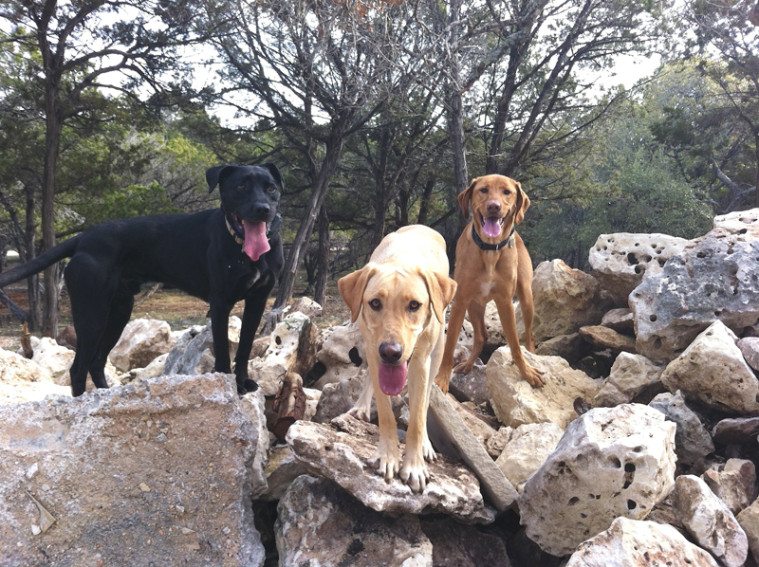
Mary and Mike Hargrove live in Colleyville, northwest of Dallas. Until 2005, Mike worked as a police officer, Mary with Child Protective Services. When the couple retired they went into the home remodeling and construction business — not a “typical full-time job,” Mike says, which gave them the flexibility to deploy at any time with the search and rescue organizations.
Mary’s dog, Duke, is a 5-year-old Labrador mix who was found tied to a tree in a Fort Worth park when he was just eight weeks old. The Hargrove’s neighbors took him in but he became too energetic for them to handle and when he was about five months they took him to a shelter. Mary happened to be outside her house as they were loading Duke in the car and she adopted him. “He turned out to be a very well-suited for search and rescue work,” Mike says.
Mike was partnered with Hayden in 2011. The dog had clearly been abused in California before the Search Dog Foundation took him in. There was evidence around his muzzle that his mouth had been wired shut. He’s a black dog, but he now has this white ring around his nose and underneath his chin where the wire had cut into his flesh.
The foundation noticed Hayden had what they term a high toy drive. “Toys are what you use to adjust their behavior,” Mike explains. “The majority of search dogs are high toy drive dogs. It’s all fun and games to them — they’re looking for someone who is going to tug or play with them in some fashion. Food is a little harder to work with.”
Both Hayden and Duke have been trained to search up to 60 acres of wilderness and woodland in one day’s deployment — all the time thinking there’s somebody out in those woods who is going to play with them. If it’s in the height of the Texas summer, Mike and Mary have to take it much slower. “It can be taxing on everyone,” Mary says.
The couple works the dogs hard, and when they’re back at home, they like to run around the backyard, wrestle and chase grasshoppers. “They’re just dogs that have a very unique talent,” Mary says, looking at the pair laying sprawled our on the living room floor, Hayden on his back with his feet in the air.
“When they’re not working or training we treat them like a member of the family,” Mike adds. “We love the heck out of the dogs.”
For anyone wanting to join a search and rescue team like Texas Task Force II, one of the most important skills is navigation. “In hundreds of acres of woodland, you have to be able to figure out where you are and how to get out of there; what areas have been covered and what haven’t,” Mike says. “There’s a lot of mapping and GPS work.”
Another thing you’ll have to be able to handle is the tragedy of discovering that the person you are looking for is already dead. “It takes its toll after the fact,” Mary says. “The big thing for me is rest. You’ve been working, sometimes for hours on end and with limited food — we could be sent out at 10 p.m. and not get back until 7 or 8 the next morning. By the time we’re finished, we’re just tired.”
